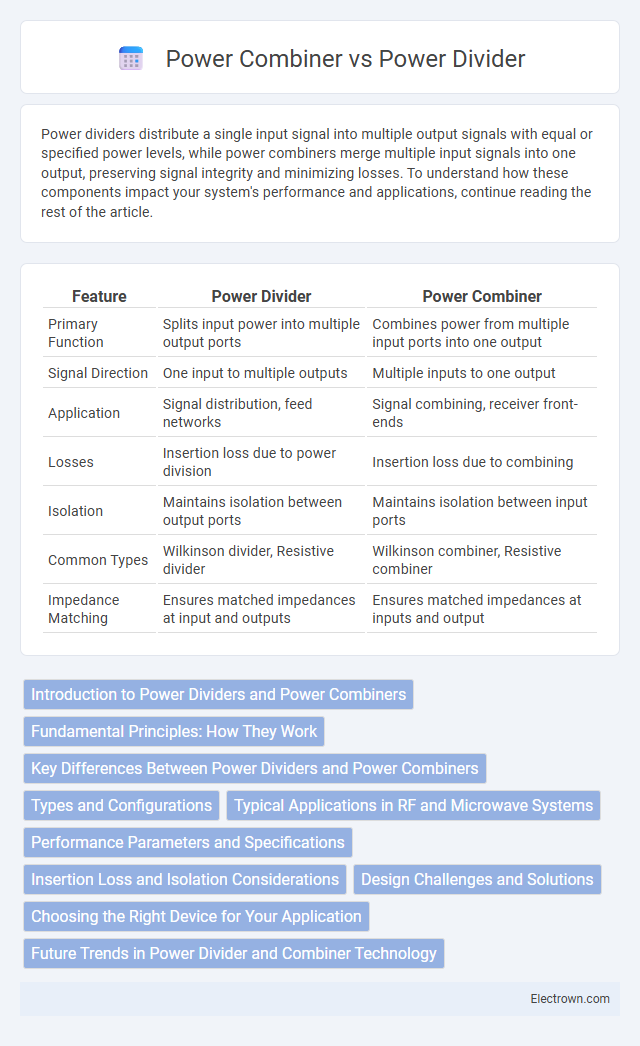Power dividers distribute a single input signal into multiple output signals with equal or specified power levels, while power combiners merge multiple input signals into one output, preserving signal integrity and minimizing losses. To understand how these components impact your system's performance and applications, continue reading the rest of the article.
Table of Comparison
| Feature | Power Divider | Power Combiner |
|---|---|---|
| Primary Function | Splits input power into multiple output ports | Combines power from multiple input ports into one output |
| Signal Direction | One input to multiple outputs | Multiple inputs to one output |
| Application | Signal distribution, feed networks | Signal combining, receiver front-ends |
| Losses | Insertion loss due to power division | Insertion loss due to combining |
| Isolation | Maintains isolation between output ports | Maintains isolation between input ports |
| Common Types | Wilkinson divider, Resistive divider | Wilkinson combiner, Resistive combiner |
| Impedance Matching | Ensures matched impedances at input and outputs | Ensures matched impedances at inputs and output |
Introduction to Power Dividers and Power Combiners
Power dividers and power combiners are essential components in RF and microwave systems used to split or combine signal power efficiently. Power dividers evenly distribute an input signal into multiple output ports without significantly affecting signal integrity, whereas power combiners merge multiple input signals into a single output. Both devices are critical for applications in communication systems, test setups, and antenna arrays, with designs optimized for minimal insertion loss and maximum isolation.
Fundamental Principles: How They Work
Power dividers split an input signal into multiple output signals with equal or specified power levels while maintaining impedance matching to prevent signal reflection. Power combiners function by merging multiple input signals into a single output, efficiently adding their power while minimizing losses and maintaining impedance continuity. Your choice depends on whether the application requires signal distribution or consolidation in RF and microwave systems.
Key Differences Between Power Dividers and Power Combiners
Power dividers split an input signal into multiple outputs with equal or specified power levels, maintaining signal integrity and impedance matching. Power combiners merge multiple input signals into a single output while minimizing loss and preventing interference between sources. The primary difference lies in their function: power dividers distribute power, whereas power combiners aggregate power for applications in RF and microwave systems.
Types and Configurations
Power dividers and power combiners share similar configurations but serve opposite functions, with common types including resistive, Wilkinson, and hybrid couplers. Wilkinson power dividers provide isolation and impedance matching, making them ideal for RF and microwave circuits where signal integrity is critical. Your choice depends on application requirements such as frequency range, power handling, and isolation, as resistive dividers are simple but lossy while hybrid couplers offer balanced signal splitting and combining with low loss.
Typical Applications in RF and Microwave Systems
Power dividers are essential in RF and microwave systems for distributing signals evenly to multiple components such as antennas or amplifiers, commonly used in phased array antennas and parallel signal processing. Power combiners serve to aggregate signals from multiple sources into a single output, frequently utilized in transmitter systems to boost output power and in receiver systems for signal diversity. Both devices optimize signal routing and power management, enhancing system performance in communications, radar, and wireless infrastructure.
Performance Parameters and Specifications
Power dividers and power combiners share key performance parameters such as insertion loss, isolation, return loss, and power handling capacity, which determine their effectiveness in RF and microwave systems. Power dividers typically emphasize equal power distribution with minimal insertion loss and high isolation between output ports, while power combiners focus on efficiently summing multiple input signals with low loss and maintaining impedance matching to prevent reflection. Understanding these specifications helps you select the right device for achieving optimal signal integrity and system performance.
Insertion Loss and Isolation Considerations
Insertion loss in power dividers results from signal splitting, causing reduced output power, whereas in power combiners, insertion loss arises from signal combining inefficiencies and mismatched input phases. Isolation is crucial for power dividers to prevent interaction between output ports, maintaining signal integrity, while in power combiners, isolation helps avoid signal reflection and interference among inputs. Understanding these key differences allows you to optimize your RF system performance by selecting the appropriate device based on insertion loss and isolation requirements.
Design Challenges and Solutions
Design challenges of power dividers and power combiners predominantly involve minimizing insertion loss, ensuring impedance matching, and maintaining isolation between ports to prevent signal interference. Solutions include employing advanced matching networks, using resistive or Wilkinson designs for enhanced isolation, and optimizing layout symmetry to reduce phase and amplitude imbalance. Your system performance improves significantly when these design optimizations address issues like power handling and bandwidth limitations effectively.
Choosing the Right Device for Your Application
Selecting between a power divider and power combiner depends on the direction of signal flow and system requirements; power dividers split a single input signal into multiple outputs with minimal loss, ideal for distributing signals in antenna arrays or test setups. Power combiners merge multiple input signals into one output, commonly used in transmitters to aggregate power from multiple sources or combine signal paths. Understanding your application's need for signal splitting or combining, isolation, and power handling capacity is crucial for optimal device selection.
Future Trends in Power Divider and Combiner Technology
Future trends in power divider and combiner technology emphasize enhanced integration with 5G and 6G communication systems, enabling higher frequency operations and improved bandwidth efficiency. Advanced materials like metamaterials and silicon photonics are driving miniaturization and performance improvements in RF and microwave circuits. Your wireless systems will benefit from these innovations through increased signal integrity, lower insertion loss, and greater power-handling capabilities.
Power Divider vs Power Combiner Infographic

 electrown.com
electrown.com